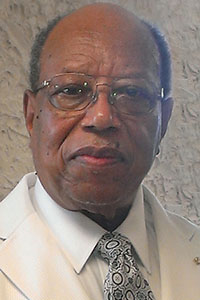“Photographs open doors into the past, but they also allow a look into the future.”
The quote by Sally Mann, a renowned American photographer, sums up the power of a photo that recently connected the past and present of a father and daughter employed by Eskenazi Health.
One day while walking by the History of Healing display on the lower level of the Fifth Third Bank Building, Joyce Tracy noticed a photo that showed a man she recognized. She asked herself, “Why does he look so familiar?” Then it dawned on her – “That’s my daddy!”
The black-and-white image was taken around 1962. Tracy is currently a charge specialist in Critical Care. She has been employed here for nearly 24 years. Her father, Robert Fields, worked here for more than two years in the early 1960s when the health system was known as General Hospital.
With the realization that her father’s image was among the artifacts celebrating the storied history of the hospital, she contacted her dad that evening. Tracy said, “Guess what?” He said, “What?” “They have a picture of you hanging up in the museum,” Tracy answered. The 77-year-old recently shared his response – “I was surprised, really.”
 |
 |
|
Robert Fields
|
Joyce Tracy
|
Fields remembers the day of the photo. Accompanied by a nurse and an assistant, he had just returned from X-ray wheeling a patient. A photographer captured the image for an employee newsletter. The photo shows a checkered floor, high ceilings, wooden furniture, stainless steel bed frame, a fire extinguisher and a nurse looking at the patient’s chart.
Fields served as an orderly, which is an attendant in a hospital unit who assists in the care of patients. In the early 1960s, men were orderlies, and women were assistants. Both helped ease the workload of nurses. Fields fondly recalled his duties – taking temperatures, checking pulses and monitoring respirations. Other tasks included assisting patients with hygiene and meals and reducing fall risks as well as transporting patients and maintaining patient rooms.
Fields reminisced about Betty McElfresh, the head nurse who led the training program for orderlies. He also remembered the superintendent of the hospital, Dr. Arvine Popplewell. Fields and Tracy worked at Eskenazi Health more than 30 years apart, and many things have changed – names, buildings, procedures and protocols.
Fields described the two hourglass bottles that created suction used to draw fluids out of patients to help prevent infection. The “old Stryker beds” allowed staff to rotate certain patients with a hand crank. Wheelchairs contained mostly wooden parts, including the spokes in the wheels.
“I’ll never forget,” Fields said of his time at the hospital.
Of all the differences between Fields’ tenure and the present, two things have remained steadfast – the camaraderie among staff and the deep level of care provided to patients.
“Once the employees got to know each other, it was like a family atmosphere,” Fields said.
Just like Tracy does when a nurse needs assistance, Fields stepped up without hesitation. Whatever needed to be done, staff lent a hand to ensure patients received the care they deserved. Fields said staff genuinely cared for each other and the patients. Tracy said the same environment exists today.
“We’re always willing to help somebody,” she said.
Karen Tucker, the associate director of Critical Care, said Tracy embodies the PRIDE values – Professionalism, Respect, Innovation, Development and Excellence.
“She is a wonderful employee, and we are lucky to have her on our team,” Tucker said.
While Fields is from Eskenazi Health’s past, he shared his care and compassion with his daughter, who represents the level of care here. The old photo not only provided a snapshot of history, it also offered a glimpse into the future.